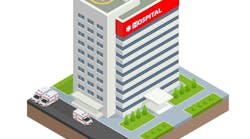LAWRENCE, Mass. -- A sign of increasing recognition from the healthcare community for its distinction in performance and payback, Radianse, Inc. today announced four new installations of its active-RFID indoor positioning solution (IPS), each expected to increase efficiencies, enhance safety and reduce costs.
Yale-New Haven Hospital, New Haven, Connecticut, installed a Radianse IPS to improve equipment management and patient and staff flows across Perioperative Services and the Cardiac Thoracic Intensive Care unit. Close to a thousand pieces of medical equipment are covered by a Radianse IPS, so wherever equipment is located -- from central supply to the post anesthesia care unit -- it can be immediately found using a simple, web-based search. That same search function can be used to locate a number of managers who wear Radianse active-RFID location tags in the first phase of staff location. When patient location is deployed later this year, the hospital plans to use Radianse single-use active-RFID tags, a wristwatch-sized device designed to maximize comfort, safety and convenience across a patient's length of stay.
PinnacleHealth Hospitals, Harrisburg, Pennsylvania, installed a Radianse IPS at Harrisburg and Community Campuses, in collaboration with Radianse partner PeriOptimum. Real-time patient location, including objective time-stamps for any defined clinical event, are automatically recorded in PeriOptimum's workflow management application, improving communications among surgical staff and with patients' families, patient flow and enabling accurate measurements of significant events to identify and adapt inefficient processes.
St. Vincent's Hospital, Birmingham, Alabama, a member of Ascension Health, installed a Radianse IPS in collaboration with Awarix. Radianse active-RFID location tags are assigned to inpatients and outpatients whose care plans require procedures in the Cath Lab, Radiology and Gastrointestinal departments. The combined solution is designed to help hospitals increase capacity as it improves care.
Simplicity and sophistication of Radianse IPS the deciding factors
"We needed a breadth of applications, along with a simple solution to install and expand," said Joe Lederer, director of Perioperative Support Systems at Yale-New Haven Hospital. "We started with equipment tracking and are using the data for a utilization study. We wanted a database that would help us improve equipment management. When we move forward with patient location we expect to make positive changes to improve patient flow."
Craig Wisman, MD, MMM, vice president of medical affairs for PinnacleHealth, calls real-time location the key to effective perioperative workflow management. "We looked at many possible ways to enter real-time location and each had significant drawbacks, particularly when compared to a solution that is essentially hands-off from start to finish. I am a firm believer in indoor positioning. Everyone knows where each patient is and who is ready for what -- and we've just begun to tap into the potential of the Radianse system."
St. Vincent's Hospital, recognized nationally for its technology initiatives, also evaluated varying approaches, according to Tim Stettheimer, the hospital's vice president and chief information officer. "We looked at all the current location technologies and chose this solution because it was able to provide the precision we needed. We have hundreds of active-RFID tags that we can assign to patients as we need, and we have the flexibility to scale the solution as necessary."
Mike Dempsey, chief technology officer of Radianse said, "From our first installation at Massachusetts General Hospital, where so much potential for indoor positioning has been realized, to the successes of the past year at Hannibal Regional Hospital in Hannibal, Missouri, the Radianse vision mirrors that of each of our customers: to make healthcare smarter and safer."
(c) 2005 Business Wire

